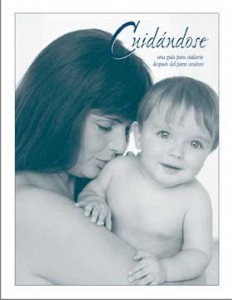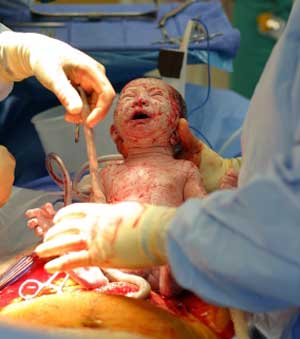Not too long ago, new mothers stayed in bed for a week or longer after giving birth. Much of this time was spent in the hospital where both mother and her new baby received constant care. Studies now show that early discharge is generally safe for both mother and baby. Bonding begins sooner, less time away from home is less upsetting for the household, and mothers feel more confident at home. Today, hospital stays for cesarean births without problems are usually three to five days.
Once your baby is born, your body will change both physically and emotionally throughout the next year. Many of these changes happen in the first 6 weeks, called postpartum. Postpartum isn’t a time of illness, but a time of healthy change. Some changes restore your body to its non-pregnant state. Other changes allow you to provide food, care, and love for your newborn.
It is important for you to spend time everyday caring for yourself both physically and emotionally. Your body will begin healing itself and getting rid of excess water. Your uterus will shrink back to its non-pregnant size. Postpartum is also a time of hormonal change and emotional adjustment. With all that is happening to you in such a short time, the first 6 weeks can also be a time of stress. Sometimes new moms can become so focused on their role as a new parent that they forget about their own needs. However, it is important for you to spend time everyday caring for yourself both physically and emotionally. Caring for yourself includes monitoring your health by learning what to expect, what is “normal,” and how to tell if there is a problem.
Tips for Caring for Yourself After Your C-Section
Pain
- Follow your doctor’s recommendations on taking pain medication
- Keep a record of when you take a pain pill, what pill it was, and if you took 1 or 2
- Try to space out and alternate different pain medications (for example, if you are prescribed Tylenol and Ibuprofen: take Ibuprofen and then 2 hours later take Tylenol)
- Use ice packs for incision pain (only ice for 20-30 minutes at a time)
- Use warm towel for cramping pain
- Take it easy! Even a “quick trip” to the grocery store can seem really exhausting when you are recovering. If your pain or bleeding increases due to activity take that as a sign to stop and slow down.
Wound Care
- Keep your incision open to the air (do not keep a dressing on it), unless directed otherwise by your doctor.
- Keep your incision clean and dry. It is okay to wash it in the shower with warm, soapy water and then pat dry afterward.
- Some people’s incision is covered by abdominal skin and fat. If your incision is unable to dry well because of this, try laying flat on your back for awhile and lifting the fold of skin up for awhile to get fresh air to the incision.
- Look at your incision, or have someone else look at it, to monitor for drainage, bleeding or increased bruising or redness. If you have these things call your doctor.
- You might be discharged home with staples in your incision. If this is the case, don’t pick at the staples.
Bleeding
- You will have vaginal bleeding for about 1 week after giving birth (vaginal or C-Section).
- 2-4 days after delivery the bleeding will be much lighter, more watery and pinker in color.
- About 10 days after delivery the bleeding will be mostly watery, maybe slightly tinged pink.
- If you have an increase in bleeding or clots call your doctor.
- Do not use tampons, only pads.
Perineal Care
Some people have a scheduled C-section and do not necessarily go through labor before their surgery, while other women may go through hours of labor and even pushing before they have surgery. If you went through labor and pushing, and then had a C-section you have two really painful areas to recover–perineal and abdominal incision. Some women may have even had vaginal tearing and/or stitches in addition to their cesarean section incision.
- Take a stool softener. Straining can be hard on the abdominal incision as well as perineal trauma.
- Change your pad every 1-2 hours.
- Use a small ice pack for perineal pain (20-30 minutes). A baby’s diaper can actually work well for this–cut a hole near the top of the diaper and stuff ice cubes into the lining. Place the open diaper in your underwear. This works well as it helps to absorb blood and keeps the area cold.
- If you have stitches, they will likely fall out on their own. You may notice a small black string or thread in your pad or underwear–don’t be alarmed, this is the material for the stitch.
- Wipe from front to back! Wiping from back to front increases the chance of developing a urinary tract infection as well as an infection to the vagina or uterus as feces carries lots of bacteria.
- If you notice a foul smell or colored discharge call your doctor, you may have an infection.
- Sitz bath may be helpful. Warm water to the perineal area promotes healing and provides pain relief. It is not a good idea to soak in a bathtub, but a sitz bath for 20-30 minutes may feel really good.
Exercise
- Slowly increase your activity over six weeks.
- At 6-8 weeks you may be able to resume activities that were normal for you prior to your C-section.
- If an activity you are doing causes you pain or increases your bleeding, stop and rest.
Diet and Nutrition
- Eat small frequent, healthy meals.
- Eat foods that are high in fiber to promote easier bowel movements.
- Avoid foods that cause intestinal gas, as this can add to the discomfort of your abdominal incision and uterine cramping.
- Drink lots of water! 64 ounces per day is recommended.
Emotional & Mental Wellbeing
- Emotional highs and lows can be very common and seem very irregular in the postpartum recovery period.
- Postpartum depression and baby blues are not uncommon. If you are feeling low, sad, depressed, have thoughts of harming yourself or your baby call your doctor–ask for help right away.
- Women who have had an unplanned C-section may experience grief afterward if they view the experience to not delivery vaginally as a loss. Talk to your doctor about these feelings, they are common.
- Take care of yourself. Try to take a short walk outside, read a book, listen to music, or do another activity that is just for you at least once per day.
Do’s & Don’ts after C-Section
- Do drink lots of water.
- Do eat healthy.
- Don’t have intercourse (or put anything in the vagina–like tampons or douches) for at least six weeks after delivery.
- Do take your temperature if you experience chills or think you have a fever.
- Don’t soak in the bathtub. This would be lovely of course, but it increases risk of infection and really should be avoided for the first 6 weeks postpartum.
- Do ask for help!
- Do take naps when your baby naps.
- Don’t take on activities or outings that are all day events. (Make sure that if you do something fun you have the strength and energy to get yourself home too!)
- Do take a stool softener and do take your pain medications. This is not the time to ‘be a hero’ and see if you can go without pain medication. If you don’t like the way you feel with the medication your doctor prescribed, call them and ask if they have any other suggestions.
When to Call the Doctor
If you are experiencing any of the following signs or symptoms, call your doctor–don’t wait for your 6-week appointment to go over these things!
- If you have an increase in bleeding or clots from the vagina
- If you have a foul odor or colored discharge from the vagina
- If you have bleeding or discharge or foul odor from your abdominal incision
- If your incision comes apart
- If your pain is uncontrolled by the medications they’ve prescribed
- If you have a fever
- If you have thoughts of harming yourself or your baby or are experiencing depression
Resources: Self Care After Cesarean Birth
Thousands of Caring for Yourself, A Guide to Self-care After Cesarean Birth booklets are purchased in English and Spanish each year by hospitals and pediatricians across the U.S. to give to new moms. It is used in childbirth preparation classes by many hospitals, churches, and childbirth educators. Because hospital and health care budgets are shrinking, Media Partners has decided to make the information available online. We hope it helps with tight education budgets!
Introduction to Self-care After Cesarean Birth
Preventive Self Care
Perineal Care
Physical Changes and Healing
Vaginal Birth After Cesarean (VBAC)
Breast Care
Activities and Healthy Exercise
Nutrition and Diet
Family Planning and Birth Control
Normal “Baby Blues” or Postpartum Depression
Your Postpartum Check-Up
Get as Much Rest as You Can
When to Call Your Doctor
EXPERT ADVISORS:
Linda Abercrombie, RNC, CCE
Marcy Mann, MD
The information in the booklet follows the guidelines of the American Academy of Pediatrics and the American College of Obstetrics and Gynecology.
 Caring for Your Self After Cesarean Birth is also available in Español as a pdf.
Caring for Your Self After Cesarean Birth is also available in Español as a pdf.
Copyright © 1997-2010 Media Partners, Inc.
All rights reserved.—no part of this book may be photocopied, reprinted or otherwise
reproduced.
Media Partners, Inc.
3883 Rogers Bridge Rd Suite 201 A
Duluth, GA 30097
www.MediaPartnersInc.com
This booklet tells you what to expect while your body is healing and changing. In addition to telling you about changes in your body, this booklet tells you ways to speed healing and prevent problems, when to ask for help or advice, and what you can do to take the best care of yourself. In the margins there are TIPs to make self-care easier and FYI (For Your Information) when you want to learn more. Outside resources are given in LEARN MORE ABOUT IT.
More About Self Care After Cesarean Birth
Introduction to Self-care After Cesarean Birth
Preventive Self Care
Perineal Care
Physical Changes and Healing
Vaginal Birth After Cesarean (VBAC)
Breast Care
Activities and Healthy Exercise
Nutrition and Diet
Family Planning and Birth Control
Normal “Baby Blues” or Postpartum Depression
Your Postpartum Check-Up
Get as Much Rest as You Can
When to Call Your Doctor

FYI
Postpartum usually refers to the first 6 weeks after birth.
Hemorrhage means losing a lot of blood in a very short time. You can learn more about hemorrhage and how to recognize the signs of hemorrhage on page 5.
The perineum is the area between the vagina and the rectum and both thighs.